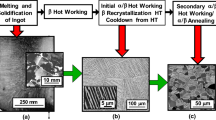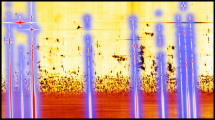Abstract
Pop-ins on nanoindentation load–displacement curves of a ferritic steel were correlated with yield drops on its tensile stress–strain curves. To investigate the relationship between these two phenomena, nanoindentation and tensile tests were performed on annealed specimens, prestrained specimens, and specimens aged for various times after prestraining. Clear nanoindentation pop-ins were observed on annealed specimens, which disappeared when specimens were indented right after the prestrain, but reappeared to varying degrees after strain aging. Yield drops in tensile tests showed similar disappearance and appearance, indicating that the two phenomena, at the nano- and macro-scale, respectively, are closely related and influenced by dislocation locking by solutes (Cottrell atmospheres).





Similar content being viewed by others
References
W.W. Gerberich, J.C. Nelson, E.T. Lilleodden, P. Anderson, and J.T. Wyrobek: Indentation included dislocation nucleation: The initial yield point. Acta Mater. 44, 3585 (1996).
S.G. Corcoran, R.J. Colton, E.T. Lilleodden, and W.W. Gerberich: Anomalous plastic deformation at surfaces: Nanoindentations of gold single crystals. Phys. Rev. B 55, R16057 (1997).
D.F. Bahr, D.E. Kramer, and W.W. Gerberich: Non-linear deformation mechanisms during nanoindentation. Acta Mater. 46, 3605 (1998).
C.L. Kelchner, S.J. Plimpton, and J.C. Hamilton: Dislocation nucleation and defect structure during surface indentation. Phys. Rev. B 58, 11085 (1998).
E.B. Tadmor, R. Miller, R. Phillips, and M. Ortiz: Nanoindentation and incipient plasticity. J. Mater. Res. 14, 2233 (1999).
A. Gouldstone, H-J. Koh, K-Y. Zeng, A.E. Giannakopoulos, and S. Suresh: Discrete and continuous deformation during nanoindentation of thin films. Acta Mater. 48, 2277 (2000).
M. Goken and M. Kempf: Pop-ins in nanoindentation-the initial yield point. Z. Metallk. 92, 1061 (2001).
A. Gouldstone, K.J. Van Vliet, and S. Suresh: Simulation of defect nucleation in a crystal. Nature 411, 656 (2001).
E.T. Lilleodden, J.A. Zimmerman, S.M. Foiles, and W.D. Nix: Atomistic simulations of elastic deformation and dislocation nucleation during nanoindentation. J. Mech. Phys. Solids 51, 901 (2003).
H. Bei, E.P. George, J.L. Hay, and G.M. Pharr: Influence of indenter tip geometry on elastic deformation during nanoindentation. Phys. Rev. Lett. 95, 045501 (2005).
T. Ohmura and K. Tsuzaki: Plasticity initiation and subsequent deformation behavior in the vicinity of single grain boundary investigated through nanoindentation technique. J. Mater. Sci. 42, 1728 (2007).
A.A. Zbib and D.F. Bahr: Dislocation nucleation and source activation during nanoindentation yield points. Metall. Mater. Trans. A 38A, 2249 (2007).
H. Bei, Y.F. Gao, S. Shim, E.P. George, and G.M. Pharr: Strength differences arising from homogeneous versus heterogeneous dislocation nucleation. Phys. Rev. B 77, 060103(R) (2008).
S. Shim, H. Bei, E.P. George, and G.M. Pharr: A different type of indentation size effect. Scr. Mater. 59, 1095 (2008).
A. Barnoush, M.T. Welsch, and H. Vehoff: Correlation between dislocation density and pop-in phenomena in aluminum studied by nanoindentation and electron channeling contrast imaging. Scr. Mater. 63, 465 (2010).
T-H. Ahn, C-S. Oh, D.H. Kim, K.H. Oh, H. Bei, E.P. George, and H.N. Han: Investigation of strain-induced martensitic transformation in metastable austenite using nanoindentation. Scr. Mater. 63, 540 (2010).
S.M. Han, T. Bozorg-Grayeli, J.R. Groves, and W.D. Nix: Size effects on strength and plasticity of vanadium nanopillars. Scr. Mater. 63, 1153 (2010).
C. Begau, A. Hartmaier, E.P. George, and G.M. Pharr: Atomistic processes of dislocation generation and plastic deformation during nanoindentation. Acta Mater. 59, 934 (2011).
G.M. Pharr, W.C. Oliver, and D.R. Clarke: Hysteresis and discontinuity in the indentation load-displacement behavior of silicon. Scr. Metall. 23, 1949 (1989).
G.M. Pharr, W.C. Oliver, and D.S. Harding: New evidence for a pressure-induced phase transformation during the indentation of silicon. J. Mater. Res. 6, 1129 (1991).
T.F. Page, W.C. Oliver, and C.J. McHargue: The deformation behavior of ceramic crystals subjected to very low load (nano)indentations. J. Mater. Res. 7, 450 (1992).
D.L. Callahan, and J.C. Morris: Extent of phase transformation in silicon hardness indentations. J. Mater. Res. 7, 1614 (1992).
E.R. Weppelmann, J.S. Field, and M.V. Swain: Observation, analysis, and simulation of the hysteresis of silicon using ultra-micro-indentation with spherical indenters. J. Mater. Res. 8, 830 (1993).
E.R. Weppelmann, J.S. Field, and M.V. Swain: Influence of spherical indentor radius on the indentation-induced transformation behaviour of silicon. J. Mater. Sci. 30, 2455 (1995).
H.N. Han, and D-W. Suh: A model for transformation plasticity during bainite transformation of steel under external stress. Acta Mater. 51, 4907 (2003).
H.N. Han, C.G. Lee, C-S. Oh, T-H. Lee, and S-J. Kim: A model for deformation behavior and mechanically induced martensitic transformation of metastable austenitic steel. Acta Mater. 52, 5203 (2004).
J-I. Jang, M.J. Lance, S. Wen, T.Y. Tsui, and G.M. Pharr: Indentation-induced phase transformations in silicon: Influences of load, rate and indenter angle on the transformation behavior. Acta Mater. 53, 1759 (2005).
H.N. Han, C-G. Lee, D-W. Suh, and S-J. Kim: A microstructure-based analysis for transformation induced plasticity and mechanically induced martensitic transformation. Mater. Sci. Eng., A 485, 224 (2008).
H.N. Han, C-S. Oh, G. Kim, and O. Kwon: Design method for TRIP-aided multiphase steel based on a microstructure-based modelling for transformation-induced plasticity and mechanically induced martensitic transformation. Mater. Sci. Eng., A 499, 462 (2009).
M-G. Lee, S-J. Kim, and H.N. Han: Crystal plasticity finite element modeling of mechanically induced martensitic transformation (MIMT) in metastable austenite. Int. J. Plast. 26, 688 (2010).
J.E. Bradby, J.S. Williams, J. Wong-Leung, M.V. Swain, and P. Munroe: Nanoindentation-induced deformation of Ge. Appl. Phys. Lett. 80, 2651 (2002).
R.D.K. Misra, Z. Zhang, Z. Jia, M.C. Somani, and L.P. Karjalainen: Probing deformation processes in near-defect free volume in high strength–high ductility nanograined/ultrafine-grained (NG/UFG) metastable austenitic stainless steels. Scr. Mater. 63, 1057 (2010).
A.H. Cottrell: Dislocations and Plastic Flow in Crystals (Oxford Univ. Press, London, England, 1953), pp. 139–150.
T-H. Ahn, K-K. Um, J-K. Choi, D.H. Kim, K.H. Oh, M. Kim, and H.N. Han: Small-scale mechanical property characterization of ferrite formed during deformation of super-cooled austenite by nanoindentation. Mater. Sci. Eng., A 523, 173 (2009).
J.Y. Kang, D.H. Kim, S-I. Baik, T-H. Ahn, Y-W. Kim, H.N. Han, K.H. Oh, H-C. Lee, and S.H. Han: Phase analysis of steels by grain-averaged EBSD functions. ISIJ Int. 51, 130 (2011).
Y.M. Kim, T-H. Ahn, K.K. Park, K.H. Oh, and H.N. Han: Identification of dynamic ferrite formed during deformation of super-cooled austenite by image-based analysis of EBSD map. Met. Mater. Int. 17, 181–186 (2011).
ASTM: E 8–00, Standard Test Methods for Tension Testing of Metallic Materials.
W.A. Soer, K.E. Aifantis, and J.Th.M. De Hosson: Incipient plasticity during nanoindentation at grain boundaries in body-centered cubic metals. Acta Mater. 53, 4665 (2005).
E.T. Lilleodden and W.D. Nix: Microstructural length-scale effects in the nanoindentation behavior of thin gold films. Acta Mater. 54, 1583 (2006).
K.L. Johnson: Contact Mechanics (Cambridge University Press, Cambridge, England, 1985), pp. 84–106.
D.N. Lee: Texture and Related Phenomena (The Korean Institute of Metals and Materials, Seoul, Korea, 2006), pp. 47–107.
R.W.K. Honeycombe: Plastic Deformation of Metals, 2nd ed. (Edward Arnold, London, England, 1984), pp. 33–35.
C.A. Schuh and A.C. Lund: Application of nucleation theory to the rate dependence of incipient plasticity during nanoindentation. J. Mater. Res. 19, 2152 (2004).
W.W. Gerberich, S.K. Venkataraman, H. Huang, S.E. Harvey, and D.L. Kohlstedt: The injection of plasticity by millinewton contacts. Acta Metall. Mater. 43, 1569 (1995).
D.E. Kramer, K.B. Yoder, and W.W. Gerberich: Physics of condensed matter, structure, defects and mechanical properties. Philos. Mag. A 81, 2033 (2001).
W.C. Oliver and G.M. Pharr: Improved technique for determining hardness and elastic modulus using load and displacement sensing indentation experiments. J. Mater. Res. 7, 1564 (1992).
Y-H. Lee, H-Y. Yu, U-B. Baek, and S-H. Nahm: Analysis of residual stress through a recovery factor of remnant indents formed on artificially stressed metallic glass surfaces. Kor. J. Met. Mater. 48, 203 (2010).
Acknowledgments
This study was supported by National Research Foundation of Korea grant funded by the Ministry of Education, Science and Technology (2010-0018936). CSO is thankful for the support by a grant from the Fundamental R&D Program for Core Technology of Materials funded by the Ministry of Knowledge Economy, Republic of Korea. EPG was supported by the Materials Sciences and Engineering Division, Basic Energy Sciences, U.S. Department of Energy.
Author information
Authors and Affiliations
Corresponding author
Rights and permissions
About this article
Cite this article
Ahn, TH., Oh, CS., Lee, K. et al. Relationship between yield point phenomena and the nanoindentation pop-in behavior of steel. Journal of Materials Research 27, 39–44 (2012). https://doi.org/10.1557/jmr.2011.208
Received:
Accepted:
Published:
Issue Date:
DOI: https://doi.org/10.1557/jmr.2011.208




